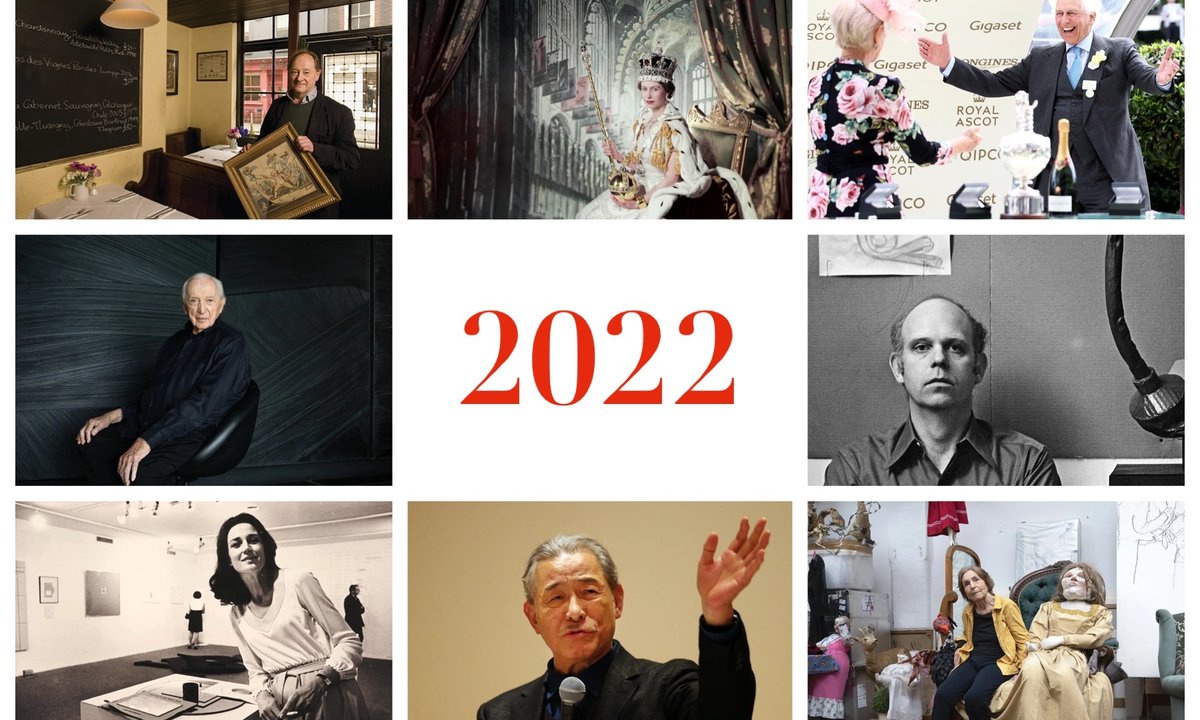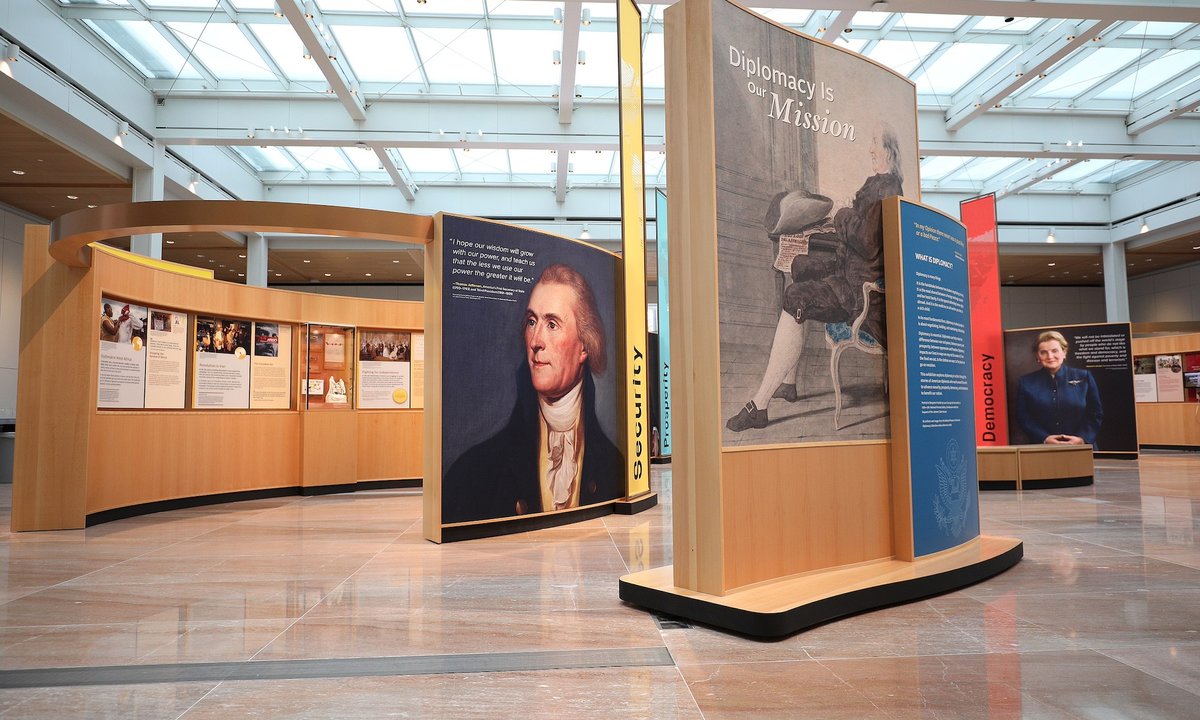A great performance artist, and monarch
The death on 8 September of Queen Elizabeth II, British monarch for 70 years, and owner in trust of one of the world’s great art collections, made global headlines for nearly a fortnight, concluding with a funeral whose ceremonial power and precision matched that of her Coronation in 1953. The Art Newspaper celebrated Elizabeth II’s mastery of the art of monarchy and how she turned her official appearances, face-to-face with the public, into a form of unflinching performance art.
Cecil Beaton: Queen Elizabeth II on her Coronation Day (1953) Royal Collection Trust/© Her Majesty Queen Elizabeth II 2021
“The visual arts per se were never the Queen’s passion,” The Art Newspaper’s editor, Alison Cole, wrote, “though in the course of her long reign the propagation of her image—from her youthful profile on stamps, to Andy Warhol’s prints, to Chris Levine’s recent holographic portraits—made her truly iconic.”
One-off artists
Paula Rego in her London studio in 2021 © Gautier Deblonde. Courtesy the artist and Victoria Miro
In June, Marina Warner remembered an unflinching character of another type in her obituary of her friend Paula Rego, an artist who “changed the aesthetics of contemporary art in Britain and further afield”, who “defied the condescension in which illustrative work and literary reference were held” and “helped to revolutionise attitudes to women artists and the representation of women’s concerns, fantasies, drives and lives, both as subjects and as makers”.
Claes Oldenburg, pictured in 1970 Photo: Jack Mitchell/Getty Images
Other artists of note who died in 2022 included a clutch of one-off characters.
Claes Oldenburg, maker of outsized sculptures, battled to avoid the Pop Art label with which he was saddled. “I think of sculpture in general as form and space or mass and space, and that allows me to include anything as sculpture,” he said. “Chairs as sculpture or bottles or bathtubs or anything.”
The illustrator and graphic novelist Raymond Briggs, creator of The Snowman (1978), used his charming, low-tech visual style to devastating emotional effect in his adult, anti-war books, including When the Wind Blows (1982), as much as in his beloved children’s tales and their film adaptations.
Pierre Soulages in 2019 © 2022 Artists Rights Society (ARS), New York / ADAGP, Paris. Photo: Sandra Mehl for The New York Times
Pierre Soulages, the French abstract artist, found infinite possibility, from childhood, in the colour black. “He claimed that black was not the absence of colours and that it keeps changing with the light,” Vincent Noce remembered, ” ‘absorbing all colours’—as it happens, physicists agree.”
Grenville Davey, the self-effacing Turner Prize-winning sculptor, was a Young British Artist who, Charles Darwent wrote, “preached the quiet virtues of respect for materials, form, scale and the everyday”.
Sam Gilliam: “The composition is always present, but one must let things go” Courtesy of David Kordansky Gallery, Los Angeles, and Pace Gallery. Photography by Fredrik Nilsen Studio
Sam Gilliam, the first Black artist to represent the US at the Venice Biennale, used his Drape paintings on unstretched canvas to unique effect. “My Drape paintings are never hung the same way twice,” he told The Art Newspaper in 2018. “The composition is always present, but one must let things go, be open to improvisation, spontaneity, what’s happening in a space while one works.”
Tom Phillips, the British polymath-artist created a masterpiece in perseverance withA Humument, a 50-year engagement with making a “treated” book out of a randomly chosen, three-penny, long-forgotten Victorian novel.
Mould-breaking gallerists
Virginia Dwan in her New York gallery in 1969 Photo: Dwan Gallery records; Archives of American Art, Smithsonian Institution
Two art dealers well out of the ordinary run of gallerists died in 2022.
Virginia Dwan, the US’s first bicoastal gallerist, gave early support to artists working with Minimalism and Land Art that was as historically important as Durand-Ruel and Kahnweiler’s had been for Impressionism and Cubism in earlier generations. She died weeks after Michael Heizer’s vast Land Art installation, City—which she had helped fund with a loan 50 years before—was finally declared finished. “I still believe today what I thought when Heizer began,” Dwan wrote. “That this work demanded to be built…”
Andrew Edmunds in his Lexington Street restaurant, with an engraving from his neighbouring print shop Courtesy of dannyelwes.com/www.Pix4PR.com
Andrew Edmunds, the London art dealer and restaurateur, was a world expert on the prints of William Hogarth, James Gillray and Thomas Rowlandson and a true character, known as “the Duke of Lexington Street”, who kept his gallery next door to his dining club, creating a special and vivid chapter in the long and colourful history of the city’s Soho district.
An indispensable critic
After immersing himself in the poetry scene of New York’s Greenwich Village during the 1960s, Peter Schjeldahl went on to become the long-standing art critic of The New Yorker Photo: Chris Felver/Getty Images
In 2022 the art world lost a one-off, characterful, critic, Peter Schjeldahl, formerly of the Village Voice and for many years of The New Yorker. He was, Matthew Holman wrote, “an indispensable art critic who wrote with the lyric observations of a poet … A respected poet as well as a critic, he was a lifelong enthusiast for painting, for New York, and for the reparative possibilities of art during times of personal and collective crisis.”
Architectural historians of character
“The supreme self-declared ‘country house snooper'”: John Harris in 1980 Photo: RIBApix
The world of architectural history lost two admired and characterful British figures with global reputations in 2022 in the shape of John Harris—who, in the words of our obituarist, Simon Swynfen Jervis, “first entered the public consciousness as the supreme self-declared ‘country house snooper’ in two electric and episodic memoirs, No Voice From The Hall (1998) and Echoing Voices (2002)” and Mark Girouard, author of the scholarly and best-selling The Victorian Country House and Life in the English Country House.
Global brand names intertwined with the art world
The Japanese fashion designer Issey Miyake speaks before the opening of his exhibition The Work of Miyake Issey at the National Art Center in Tokyo in 2016.© Yoshio Tsunoda/AFLO/Alamy Live News
Issey Miyake, a fashion brand to conjure with, and a favourite of museum costume institutes, died, aged 84. He collaborated closely with artists including Robert Rauschenberg, Christo and the Viennese-born British potter Lucie Rie. His childhood experience of the atomic bombing of Hiroshima determined him to look forward, choosing a life working with clothes, which he saw as a modern, optimistic form of creativity.
Peter Brook at his theatre, the Bouffes du Nord in Paris, in 2013 Photo: Thomas Rome
Peter Brook, the international magus of late 20th-century theatre, had a long, and symbiotic relationship with art and artists. His 1970 production of A Midsummer Night’s Dream, designed by Sally Jacobs, set a visual and metaphorical template whose influence can be felt in the history of art installations at white-cube galleries over the past half-century.
New Elizabethan patrons of the arts
John Sainsbury, chairman and chief executive of Sainsbury’s, 1973 Larry Ellis/Daily Express/Hulton Archive/Getty Images
In Britain, 2022 saw the deaths of two contemporaries of Elizabeth II’s, both captains of business on a grand scale, whose lives as advisers, patrons of the arts and givers to charity brought them into the monarch’s orbit.
John Sainsbury, head of the family grocery business, and his wife, Anya Linden, played an important part in the refurbishing or expansion of an extraordinary number of institutions: London’s National Gallery (with the Sainsbury Wing, co-funded by John’s brothers Tim and Simon), Tate Britain, British Museum, Dulwich Picture Gallery, Museum of London and Royal Opera House, and Oxford’s Ashmolean Museum.
Evelyn de Rothschild, the philanthropist and businessman, a collector of contemporary art and heir to one of the finest art collections in Britain, was also a keen supporter of horse racing PA Images/Alamy Stock Photo
Evelyn de Rothschild, who oversaw the expansion and reorganisation of his family’s historic banking business, was heir to one of the finest art collections in Britain, at Ascott, in Buckinghamshire, a noted collector of contemporary art, and a philanthropist who supported arts, health and social organisations. The contribution he made to one of his most impactful health and architectural projects, the new Evelina Hospital for children, in London, showed an attention to detail and social benefit, The Art Newspaper wrote, “worthy of the Rothschild tradition for philanthropy dating back more than two centuries”.







